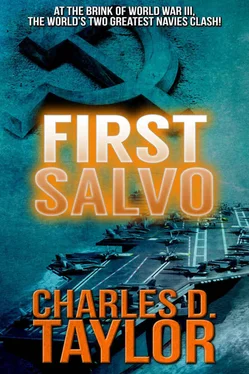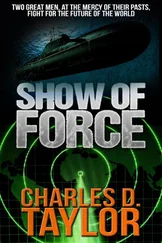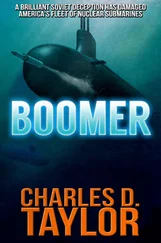“Leave anything to the imagination?” asked Pratt.
“I can’t imagine why there would be the slightest possibility of us losing if we know so much, except…” Carleton let that pass. They each knew that the Russians could provide almost the exact same intelligence on their own forces.
It still came down to three things: if Bernie Ryng had been successful and the Russians were cut off from the North Atlantic, if Cobb came out with General Keradin and was able to deliver him in one piece, and if Pratt’s battle group could control the Med, then the Soviets might pull back to their own borders, or at least halt their advance. It sounded very simple considered in that regard; it was extremely complex from the point of view of the three men in Pratt’s office aboard Kennedy.
WITH A U.S. NAVAL PICKET FORCE
Later that day, the ordeal of Admiral Pratt’s battle group began two hundred miles to the east of Kennedy and about one hundred miles north of the Libyan port of Benghazi. It was here that the guided-missile frigate Oliver Hazard Perry was assigned as a picket. She was one of the ships intended as a primary submarine barrier and to provide early warning — if U.S. Hawkeye recon aircraft were knocked out. Perry ’s basic task in early warning was to engage any Soviet submarine that was intended to take over and direct guidance of air-launched Soviet cruise missiles as they closed their targets.
Perry clearly understood there were enemy submarines in the vicinity. She was the southern element of a four-ship picket squadron, steaming at loose intervals of ten miles, the space between them covered by their own ASW helicopters.
The first indication the little ship had that she was under attack was from her own radar. An object suddenly appeared on her screen, about twenty miles distant on her port bow, traveling at high speed. It was a missile breaking the surface! Launched by a submerged submarine, it appeared sporadically on radar as it flew close to the surface.
Perry ’s captain instantly ordered his chaff canisters fired in an effort to throw the missile guidance off course. A second missile painted on the radar scope from a separate location. Another submarine!
Her captain understood his odds of steaming alone. He had no antimissile defense other than decoys, or a lucky shot from his one gun mount. His last-ditch effort would be to shoot the missiles down with his Phalanx close-in weapons system. This was a Gatling-type gun atop the hangar that spewed three thousand rounds per minute automatically at an incoming missile. But its range was less than a mile — seconds in the world of missiles. Phalanx would continue firing until its radar informed its computer there was no more missile — or it would keep firing until impact.
Perry ’s captain turned her stern to the incoming missiles; it would open Phalanx for unobstructed fire. The chaff canisters were reloaded and fired again.
Perry waited. Her crew waited. Her captain waited.
The first missile went awry, the guidance system unable to pinpoint the target. The second missile was more persistent. The ship’s single gun mount automatically fired in the direction of the missile — a futile gesture. At fifteen hundred yards, Phalanx opened fire with an incredible racket. A steady stream of bullets raced out, directed by a radar system locked on to the missile.
The noise was so ear shattering, so undeviating, that any member of Perry ’s crew within eye contact stopped what he was doing. If the missile was shot down, it was a once-in-a-lifetime experience. If the missile impacted, it didn’t matter anyway.
At approximately thirty to forty yards distant, the bullets from the Gatling gun exploded the missile’s warhead with a tremendous blast. Fragments sprayed Perry ’s stern, hangar deck, and upper deck, cutting down any man who had stopped to watch. Metal chunks tore into the after one-third of the ship. As Perry reeled from the detonation astern, the radar on Phalanx lost its target. Automatically, it ceased fire, mechanically returning to its original position even as metal fragments glanced off its small radome.
Perry ’s casualties were primarily personnel. Nothing impaired the ship’s ability to fight. Her captain wheeled her about and brought her to flank speed to close her attackers.
Aboard the Soviet submarines, the targets were obvious — four American ships, most likely frigates from the sound of their single shafts. Both subs immediately commenced reloading tubes to fire a second set of missiles; their alternate tubes contained torpedoes. It seemed, at this range, to be similar to shooting fish in a barrel. The Americans apparently did not have their helicopters in the path of the submarines. By reloading quickly the Soviets could destroy the targets before they came within torpedo range. Only the two closest American frigates provided any immediate hazard to the submarines — and these were easy targets.
Perry ’s captain deployed his helicopter in the direction of the missile launch. Within minutes the helo was dipping its sonar in the area where radar had first spotted the missile breaking water.
Contact almost instantly! Two contacts! Three… four. The sonar operator was confused — too many different sounds. Decoys! That was it — the minute the Russian submarine heard the initial ping of the sonar, it released decoys. Which was the real target? Which was the phony one?
There was only one way for Perry to tell — get weapons in the water! As Perry closed, her own sonar picked up contact. One was strong and solid. No doubt about it — classified submarine!
Even as the helo prepared to drop her first homing torpedo, Perry came within maximum torpedo range of the contacts. Saturation — that was the best way at this stage. They had no idea how many subs were in the vicinity. Splash! Perry ’s captain could see the first torpedo fall from the helo. Splash! A second in the water.
Solution complete. Ship’s torpedoes ready. Fire! Leaning over the edge of the open bridge, her commanding officer saw three torpedoes leap out of the starboard tubes at short intervals like sprinters, hitting the water with tremendous splashes. One skipped on the surface for an instant, the others dove immediately.
Her commanding officer brought the little ship parallel to the sub’s course. Can’t close them too much — too good a target.
The helo was on the way back to the ship, her torpedoes expended. He’d launch the second helo with two more torpedoes before retrieving the first. What a hell of a chance he’d be taking, slowing down and maintaining course until he could launch one, bring one home.
But the word came to the bridge with a sudden finality — the hangar doors had been jammed by the near miss of that first missile. They’d have to start cutting — fifteen to twenty minutes before they could get the doors open and clear the deck for launch.
But they couldn’t wait! There were at least two enemy subs out there. Perry was the only ship prosecuting contacts yet. Other helos were coming in. Someone had to maintain the attack.
There was a report of more missiles breaking the surface. Then, in much less time than anticipated, there was an explosion a few miles off their bow. One of the missiles had locked on to their sister ship’s incoming helo, knocking it out of the air. Perry was the only one that could keep the subs busy. Her captain turned her directly toward the underwater contacts.
By now, at least one of the torpedoes should have hit , he thought. His binoculars steadied on the horizon above where the subs should be. Nothing. Sonar continued to report multiple noises in the water. Screw beats — submarines, decoys, Perry ’s sister ship approaching from astern at flank speed. Then a report of an underwater explosion, then a second. Only two! The others must have run off.
Читать дальше












